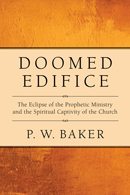P. W. Baker: Doomed Edifice
 P. W. Baker, Doomed Edifice: The Eclipse of the Prophetic Ministry and the Spiritual Captivity of the Church (Eugene, OR: Wipf & Stock, 2010), 137 pages, ISBN 9781608990405.
P. W. Baker, Doomed Edifice: The Eclipse of the Prophetic Ministry and the Spiritual Captivity of the Church (Eugene, OR: Wipf & Stock, 2010), 137 pages, ISBN 9781608990405.
Doomed Edifice is a brief historical survey of the first three centuries of ecclesial organizational and worship practices which seek to trace the development of the institutionalization of the early Christian church. P. W. Baker compares and contrasts several elements of early Christian ecclesial practices and doctrines with that of the early first century church. After an examination of these doctrines and organizational developments, Baker compares the contemporary Western church to his findings to make bold statements regarding institutional Christianity. As the title denotes, Baker’s argument is based upon his presupposition that, “the institutional church is an edifice built upon man’s wisdom and was doomed to failure” (xvi). Specifically, Baker attempts to synthesize this historical account in hopes of identifying how the prophetic ministry functioned within these churches. According to Baker, the organizational development of the episcopy and the institutionalization of these structures caused the prophetic ministries to wane and ultimately cease within this time period.
“the institutional church is an edifice built upon man’s wisdom and was doomed to failure”
Baker argues successfully for the twofold prophetic ministry and the distinctions between their operations within the first century ecclesial bodies. He clearly identifies some predominant doctrinal beliefs that influenced early Christian life and how they related to their society. Chapters six and seven are particularly interesting in that Baker introduces the premise that the rise of the episcopacy was a result of the believing community’s confrontation with heresy and persecution. He also correlates this historical development with the displaced authority of the apostles and prophets. Baker develops this argument to conclude that the idea of apostolic succession and ultimately the papacy was a human endeavor to obtain power and authority in the position of a single man. For Baker the development of the hierarchical structures and institutionalization of the church is not the same church that Jesus established. As a student of the Hebrew Bible, it is refreshing to note how Baker incorporates the concept of a fluid community as depicted within the symbolism of the tabernacle and God’s presence in its midst.
Through this restorationist ideology, Baker seeks to correct what he identifies as a marginalization of the prophetic ministries. Although, there are many variations of the usage and application of restorationism, it is apparent that Baker‘s treatise is influenced by his beliefs that a return to this primitive church model of ecclesiology will resurrect the life and vitality of the Western contemporary church. Baker drives hard to equate spiritual decay with the institutionalization of the church. However, this ideology is not new. The Radical Reformers were strong advocates for ecclesiastical primitivism. One recent expression of the primitivist urge has emerged as an apostolic-prophetic movement which has included proponents such as C. Peter Wagner, Rick Joyner and Mike Bickle.
Category: Church History, Fall 2011, Pneuma Review


